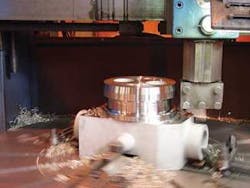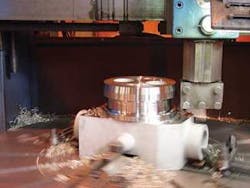Sandvik Powdermet to pursue further avenues for hot isostatic processing
The recent acquisition of Metso Powdermet by Sandvik Materials Technology brings together two established suppliers to the global offshore industry. The deal was announced in November and completed in December. In the previous fiscal year, Metso Powdermet posted sales of SEK 90 million and had an operating margin of 18%.
Bringing Sandvik Powdermet, as the company is named now, under Sandvik’s corporate roof is beneficial in a number of ways, explains Magnus Nyström, head of business development at Sandvik Materials Technology. “Firstly, it positions us even more strongly within the oil and gas, energy and medical technology sectors.
“Secondly, it provides us with important access to extensive application knowledge in powder metallurgy. We’ve previously got materials expertise with alloys and in-house powder production, but haven’t got sufficient application knowledge within the powder metallurgy area. Acquiring Powdermet provides a quicker route to that knowledge than developing it ourselves in addition to giving us the infrastructure for the development, design, and quality assurance for powder metallurgy products.
“Finally, we see strong synergies between Sandvik Materials Technology and Powdermet in terms of our global sales network. We’ve both got strong resources and a strong brand, not least in oil and gas.”
There is a large market potential that is not being tapped by powder metallurgy products which Sandvik aims to realize, Nyström says. Many of its currently forged or cast products could offer greater benefits as powder metallurgy products. Obvious examples are valve bodies, pump houses, and subsea manifolds.
Such products already are manufactured by Powdermet on a regular basis, but the predominant form of manufacture is forging and casting. Sandvik intends to launch a drive to convince the market of the advantages of products made using Powdermet’s specialist hot isostatic pressing (HIP) technology.
“It’s not novel technology, and there are major customers that fully acknowledge the benefits of HIP products already,” says Nyström. “But there’s a journey to be made to spread this knowledge and encourage wider customer awareness.”
Becoming part of the Sandvik family was also a good solution for Powdermet, in the view of managing director Carl-Gustaf Hjorth. The company enjoyed several good years as part of the Metso Corp., developing new customers and becoming more of a force in the market. When Metso decided to refocus on its core business of paper machines and minerals, Powdermet became rather marginal.
“So we were pleased to be offered the opportunity to join Sandvik and become a part of this family with such expertise within advanced materials,” says Hjorth. “The change brings us back to our central business. It’s a perfect match for us, as we can use all the background from, and good reputation of, Sandvik.”
There is an existing powder metallurgy milieu within Sandvik which Powdermet can link into: Kanthal, which makes powder metallurgy products, though not for offshore use, and Sandvik Osprey which produces fine, dispersed powders, in contrast to the coarse powders used by Powdermet. “This could be relevant for us, though we will still continue to work mainly with coarse powders,” says Hjorth.
“We will also work as before in terms of having direct contact with our clients, which is important for us. The Sandvik network will help us. We will benefit from the knowledgeable people they have around the world who will help to bring us into contact with new customers. We will benefit, too, from Sandvik’s extensive R&D resources.”
The HIP method is well suited to the production of structures with complex internal geometries that are difficult to achieve through forging or casting. A carbon steel can or mold is made in the desired shape, including internal pipe paths, and filled with powdered metal. The air is evacuated, and the can is sealed and baked in a hot isostatic press at a high temperature and pressure in the presence of argon gas. It then undergoes heat treatment and quenching, after which, the mold is pickled away.
Key properties of HIP products are their near net shape (NNS) - in other words they are completely dense - and their very even mechanical properties. Their fine microstructure makes them easy to inspect by ultrasonic techniques. The HIP process is suitable for use with a wide range of metals, including high alloyed steels, stainless steels, and super alloys.
Powdermet has received good acceptance for such products as manifolds, wye-pieces for pipelines, valve bodies, pump houses, and FPSO swivels.
The products also have a higher resistance to hydrogen induced stress cracking - HISC - than forged structures, as shown in tests carried out last year by the Sintef research institute in collaboration with the Norwegian University of Science and Technology. Full results of the tests are being presented this month at the National Association of Corrosion Engineers conference.
Meanwhile, Powdermet continues to receive a steady flow of orders, according to Göte Björman, product manager offshore. One of the main orders placed in 2006 was from Framo Engineering for a swivel in duplex stainless steel for BHP Billiton’sStybarrow FPSO.
Several orders were received from Aker Kvaerner Subsea for subsea hubs for the Dalia, Gimboa, Tyrihans, Visund, Hild, and Kristin projects. US customers placed orders for several one-metric-ton valve bodies in 254SMO, and for a 45-piece valve body in Incomel 625.
Other orders included pump houses for the Vincent field, anchor flanges, 180o 10-in. elbows in 22% duplex, and an 18 x14-in. wye-piece.
For further details, contact Carl-Gustaf Hjorth, Sandvik Powdermet. Tel +46 220 221 22, fax +46 220 334 90,[email protected], www.smt.sandvik.com

